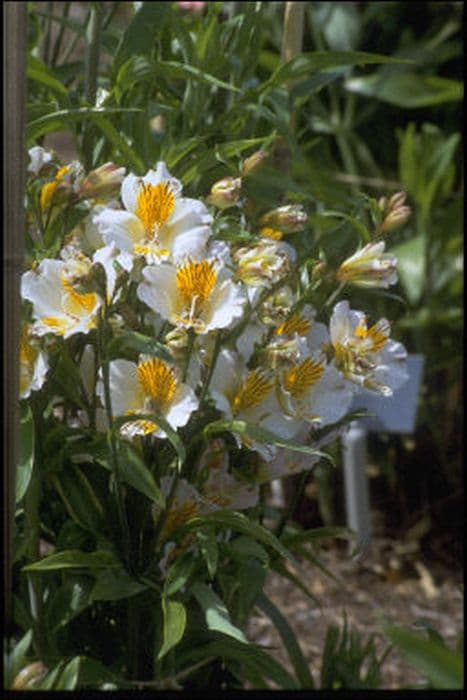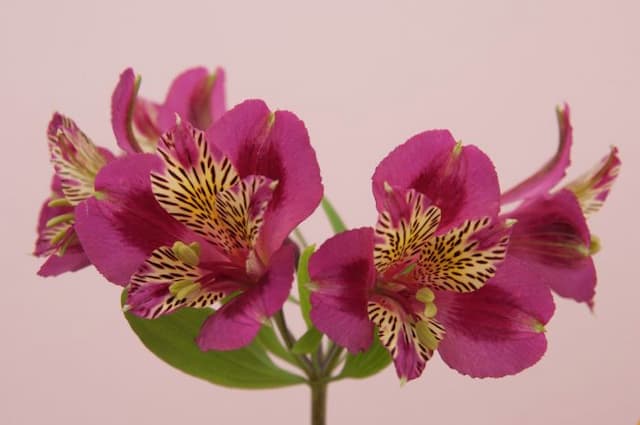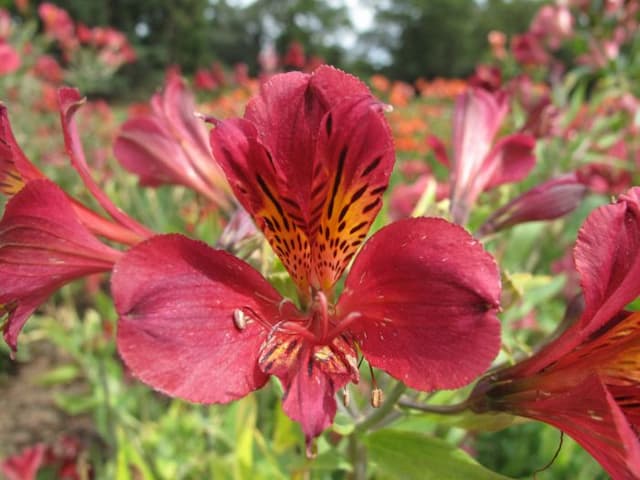Peruvian Lily Alstroemeria 'Flaming Star'

ABOUT
Alstroemeria 'Flaming Star', commonly known as Peruvian Lily or Lily of the Incas, is a striking perennial plant that showcases a lush display of vibrant blossoms. The flowers of this variety are particularly eye-catching due to their unique coloration and patterns. Each petal exhibits a blend of creamy-white and soft pink hues, adorned with bold, crimson flecking and streaks that create a flaming effect, true to the plant's name. The blossoms typically feature six slightly curved petals that form a funnel-like shape, which is characteristic of the Alstroemeria genus. These petals may also show a light dusting of yellow toward the center, adding another layer of color complexity to the already dynamic flowers. The contrasting flecks and streaks tend to draw the eye inward, emphasizing the delicate yellow stamens that protrude from the center. The leaves of 'Flaming Star' are deep green, narrow and lance-shaped, often with a twisting growth habit that adds to the overall texture of the plant. These leaves form a dense clump, creating a backdrop that makes the colorful blooms stand out even more prominently. Beyond its floral beauty, one of the enchanting features of the Peruvian Lily is the longevity of its flowers when cut. This makes 'Flaming Star' an excellent choice for bouquets and floral arrangements, where it contributes lasting vibrancy and intrigue. The plant is cherished not just for its aesthetic appeal in the garden but also for its performance as a cut flower. In summary, Alstroemeria 'Flaming Star' is a visually compelling plant, mainly due to its uniquely patterned flowers of soft pink and white with striking crimson detailing, complemented by the lush green, twisting foliage that provides substance and verdancy to its overall form.
About this plant
 Names
NamesFamily
Alstroemeriaceae
Synonyms
Peruvian Lily, Lily of the Incas
Common names
Alstroemeria 'Flaming Star'
 Toxicity
ToxicityTo humans
Peruvian Lily 'Flaming Star' is considered to have a low level of toxicity to humans. If ingested, it may cause mild gastrointestinal irritation, which can result in nausea, vomiting, or diarrhea. Contact with the sap may cause skin irritation or an allergic dermatitis in sensitive individuals. It is advisable to handle the plant with care and not consume any part of it.
To pets
Peruvian Lily 'Flaming Star' is also known to be mildly toxic to pets, such as cats and dogs. If ingested, the most common symptoms pets might experience include vomiting, diarrhea, and possible drooling. While it is not typically fatal, ingestion can cause significant discomfort to the animal and veterinary attention may be required to manage the symptoms. It is best to keep this plant out of reach of pets to avoid any potential health issues.
 Characteristics
CharacteristicsLife cycle
Perennials
Foliage type
Deciduous
Color of leaves
Green
Flower color
Pink
Height
2-3 feet (60-90 cm)
Spread
1-2 feet (30-60 cm)
Plant type
Herb
Hardiness zones
7
Native area
South America
Benefits
 General Benefits
General Benefits- Long-lasting Blooms: Alstroemeria 'Flaming Star' produces flowers that can last for several weeks, providing a long period of visual enjoyment.
- Attracts Pollinators: The vibrant flowers attract bees, butterflies, and hummingbirds, aiding in pollination.
- Versatile Use: Suitable for use in bouquets, arrangements, and as garden plants due to their colorful and striking appearance.
- Drought Tolerant: Once established, they are known for their drought tolerance, making them suitable for xeriscaping or low-water gardens.
- Low Maintenance: Requires minimal care beyond basic watering and occasional fertilization, making it ideal for those with busy lifestyles.
- Cold Resistant: It's capable of withstanding cooler temperatures, which makes it a good choice in temperate climates.
 Medical Properties
Medical PropertiesThis plant is not used for medical purposes.
 Air-purifying Qualities
Air-purifying QualitiesThis plant is not specifically known for air purifying qualities.
 Other Uses
Other Uses- Photography Prop: The striking appearance of the Alstroemeria makes it an excellent subject for photographers looking to capture the intricate patterns and vivid colors of flowers.
- Educational Tool: Botany students and educators can use Alstroemeria as a model to study plant structures such as leaves, stems, and reproductive organs.
- Artistic Inspiration: Artists may draw inspiration from the unique beauty of Alstroemeria to create paintings, drawings, or even sculptures.
- Dye Source: The colorful petals of Alstroemeria can be used to create natural dyes for textiles or craft projects.
- Culinary Garnish: Although not widely known for its edibility, the petals of the Alstroemeria could be used as a decorative, non-toxic garnish for certain dishes.
- Craft Material: Dried Alstroemeria flowers can be incorporated into homemade paper, potpourri, or other craft items for added ornamentation.
- Seasonal Decor: Alstroemeria's flowers can be dried and used in wreaths or arrangements for seasonal decorations such as for fall or spring-themed displays.
- Symbolic Gift: In the language of flowers, Alstroemeria signifies friendship and devotion, which makes it a meaningful gift between friends.
- Floral Theme Events: Alstroemeria flowers can be used as a theme for special events and weddings due to their vibrant colors and longevity.
- Garden Teaching Aid: Alstroemeria can serve as a hands-on teaching aid in garden therapy programs, helping participants learn about planting and caring for flowers.
Interesting Facts
 Feng Shui
Feng ShuiThe Peruvian Lily is not used in Feng Shui practice.
 Zodiac Sign Compitability
Zodiac Sign CompitabilityThe Peruvian Lily is not used in astrology practice.
 Plant Symbolism
Plant Symbolism- Friendship: Alstroemeria, commonly known as the Peruvian lily or lily of the Incas, often represents strong bonds of friendship due to its clustered blossoms, which are said to symbolize mutual support and connectedness.
- Devotion: The intricate patterns on the petals suggest a complexity of emotions, indicating deep commitment and devotion, making it a popular choice in bouquets exchanged between close friends or partners.
- Wealth and Prosperity: Peruvian lilies are often associated with wealth and prosperity. This is perhaps due to their full, lush appearance and the longevity of the cut flowers, which signal abundance and endurance.
- Achievement: The 'Flaming Star' variety, with its striking colors, may symbolize achievement and success. The vibrant petals could represent a person's fiery passion and drive to reach their goals.
- Strength: Given the resilience of the Peruvian lily in various climates and conditions, it can symbolize strength and the ability to withstand challenges.
 Water
WaterPeruvian lilies, including 'Flaming Star', should be watered regularly to maintain moist but not waterlogged soil. During active growth in spring and summer, water when the top inch of soil feels dry, providing about 1 to 2 gallons per week depending on the size of the plant and the weather conditions. Reduce watering in the fall and winter when the plant is not growing vigorously, offering enough to prevent the soil from drying out completely, which may be around 1 gallon every two weeks. Ensure that the plant has good drainage to prevent root rot.
 Light
LightPeruvian lilies thrive in full sun to partial shade conditions. The ideal spot for 'Flaming Star' is one where the plant receives at least six hours of sunlight a day, but it is protected from the hot afternoon sun in very warm climates. This ensures vibrant blooms and healthy growth without the risk of scorching the foliage.
 Temperature
TemperaturePeruvian lilies prefer temperatures between 65 to 80 degrees Fahrenheit for optimal growth. 'Flaming Star' can tolerate a range from about 40 degrees as a minimum to 90 degrees maximum. However, the plant may go dormant if temperatures consistently fall below 40 degrees or exceed 90 degrees Fahrenheit.
 Pruning
PruningPrune Peruvian lilies to encourage bushier growth and more flowers. For 'Flaming Star', cut back faded stems to the ground after blooming to promote new growth. This pruning can be done throughout the flowering season as needed. The best time for a major prune to rejuvenate the plant is in the spring, just as new growth begins.
 Cleaning
CleaningAs needed
 Soil
SoilThe Peruvian Lily thrives in rich, well-draining soil with a pH range of 5.5 to 7. A mix of loam, peat, and coarse sand or perlite is ideal to promote healthy growth and flowering.
 Repotting
RepottingPeruvian Lilies typically need repotting every two to three years or when they become root-bound. During repotting, divide the rhizomes to promote continued growth.
 Humidity & Misting
Humidity & MistingPeruvian Lilies prefer moderate humidity levels, around 40-60%. They do well in typical household humidity but benefit from a pebble tray or occasional misting.
 Suitable locations
Suitable locationsIndoor
Place in bright, indirect light; maintain moderate humidity.
Outdoor
Plant in partial shade with shelter from intense heat.
Hardiness zone
7-10 USDA
 Life cycle
Life cycleAlstroemeria 'Flaming Star', commonly known as the Peruvian Lily or Lily of the Incas, initiates its life cycle from a tuberous root system. The plant emerges in spring, where new shoots grow from the tubers and develop into mature stems bearing lance-shaped leaves. Flower buds form and bloom in early summer, displaying the 'Flaming Star's' distinctive bi-colored petals that attract pollinators for sexual reproduction. After the flowering stage, if pollination has occurred, the plant may produce dry capsules containing seeds, which can be dispersed to propagate new plants. Toward late summer or fall, the above-ground structure of the Alstroemeria 'Flaming Star' begins to die back as the plant enters a period of dormancy, conserving energy within its tubers. The life cycle repeats the following spring, as the tubers generate new growth to start the cycle anew.
 Propogation
PropogationPropogation time
Spring-Early Summer
The most popular method of propagation for Alstroemeria 'Flaming Star', commonly known as Peruvian Lily, is through division. This is typically done in the spring or early summer. The clumps of tubers are carefully lifted from the ground and divided by hand or with a sharp knife, making sure that each division has at least one growth point. Divisions are then replanted at the same depth they were previously growing, spaced about 12 to 18 inches (approximately 30 to 45 centimeters) apart to allow for adequate growth. Watering the newly planted divisions thoroughly helps to establish them in their new location.






![Peruvian lily [Inca Coral]](/_next/image?url=https%3A%2F%2Fplants-admin.emdemapps.com%2Fimages%2Fplants%2F%2Fimages%2F604b5b79b85ce.png&w=640&q=75)
![Peruvian lily [Inca Exotica]](/_next/image?url=https%3A%2F%2Fplants-admin.emdemapps.com%2Fimages%2Fplants%2F%2Fimages%2F604b5ec0e34a9.png&w=640&q=75)
![Peruvian lily [Inca Milk]](/_next/image?url=https%3A%2F%2Fplants-admin.emdemapps.com%2Fimages%2Fplants%2F%2Fimages%2F604b5f14b0b6a.png&w=640&q=75)
![Peruvian lily [Inticancha White Pink Blush]](/_next/image?url=https%3A%2F%2Fplants-admin.emdemapps.com%2Fimages%2Fplants%2F%2Fimages%2F604b538014919.png&w=640&q=75)